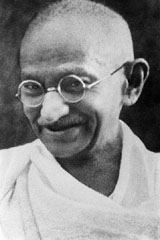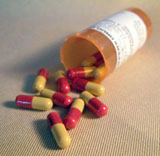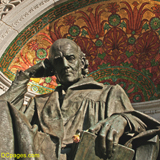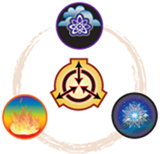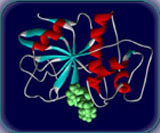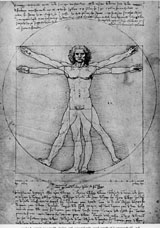Think it over
A look at paradigms of disease
Editor's note
We are living in times where alternative or complementary therapies are the norm. Yet how do we explain the contradictions that every therapy offers? Is there a way to reconcile modern medicine and an ancient system like Ayurveda? Dr. Venkatesh Palla looks at some possibilities....
It is said that Mahatma Gandhi refused to give his wife on her death bed any other treatment than naturopathy.
My friend’s uncle says that he has used Ayurveda alone since childhood and that is the secret of his health.
We see advertisements and claims that homoeopathy can cure several conditions that would need surgery in allopathy.
There is a widespread propaganda all over that praanaayaama and yoga ensure 100% mental and physical well-being and there is no need for medicines.
We often hear of energy healers of pranic healing or reiki who are able to heal diseases even from a distance.
The adherents of these systems of medicine believe in them so much that to deny them on the basis of lack of scientific evidence is to outweigh the opinion of one party over the other. Perhaps science is still too incomplete for explaining all these phenomena. But can science expand to accept all these varied statements in toto without deflecting their spirit?
Existing knowledge of the human body we gather from sciences like biology, physiology and anatomy which give us details of the gross body pertaining to the physical realm. But it fails to explain the psychological dimension of man which belongs to supra-physical realms. It fails to recognise and include in it the emotional and spiritual aspects of life. But the natural systems of medicine like Ayurveda, homoeopathy, Unani and other energy healing methods recognise this dynamic aspect of existence. Can we extend our understanding of the human body into these emotional and spiritual levels too? Can the continuity that operates between spiritual, emotional and physical levels of existence be traced throughout, making all knowledge synchronous?
This is possible if we realise the fact that the human body is not as static and tight-packed as we are habituated to see it, but is the centre of tremendous dynamic activity with which various rhythms in nature fall in and out of harmony. This understanding can be called the dynamic model of the body. Henceforth we will discuss how we can reverse our understanding from the static or physical model into a dynamic model of the body.
To begin with, let us study the salient features of the three popular systems of medicine, allopathy, homoeopathy and Ayurveda, and try to understand how they can be related with each other.
Allopathy has the background of an in-depth research supported by modern advances in biochemistry, electronics and software technology. It can study the molecular movements in the body by targeting them with radioactive markers. But it does not take into consideration the study of the mind and body as a whole, thereby giving the mind-body relationship secondary importance. It denies the spiritual fact that a cosmic energy governs creation and life and regards the body as an automaton, a self-driven machine comprised of various organs. Most of its treatment modules are planned according to this mechanical understanding of the body.
Homoeopathy was evolved in Germany by Dr. Hahnemann. After getting vexed with the old methods of treatment, he invented, with his incisive knowledge of chemistry and intuitive knowledge of creation, a special method of preparing medicines called potentisation or serial dilution whereby a medicine even in very small quantities can bring about a cure of even the most serious and intractable ailments. In homoeopathy, drugs are experimented on healthy human beings unlike in allopathy which conducts trials on animals. Being very minute in dose, the drugs do not harm the person under-going the drug trial but produce in him certain changes in mood and physical health. These changes are recorded as the symptoms caused by the drug. The symptoms that occur in several such persons are collected together to form the pharmacology of the drug. Any patient suffering from any disease is given that drug whose psychophysical expression is most similar to his symptoms of suffering. Thus is this science named homeopathy.(homeos = similar; pathos = disease). The advantages of this system are:
1. The medicines, being minute in quantity, produce no side-effects.
2. Cost-effective preparation techniques.
3. The case-taking technique in homoeopathy offers a good scope for counselling the patient thus complementing the psycho-physical action of the drug.
The disadvantages are:
1. Science cannot explain the pharmacodynamics of homoeopathic drugs. How a small quantity of medicine can bring about changes in the health is elusive to both practitioners of homoeopathy and scientists alike.
2. There is no clear-cut description of patho-genesis in homoeopathy. Though Hahnemann grouped the diseases into three fundamental groups called miasms, its application is impractical in chronic diseases in which all the miasms are mixed up. They are more or less present in every case in one pattern or the other which makes the classification non-utilitarian. Also the stages of development of an individual pathology in terms of organic changes or symptoms cannot be explained if we follow the miasm theory.
3. Hahnemann stated that the vital force, a dynamic esse which operates the physical body, is the cause of health, disease and cure. But the elaboration of this vital force is not done, leading to many conjectures among its practitioners regarding its application in health, disease and cure.
Ayurveda is the most ancient of all the systems of medicine. It takes up a detailed study of health problems on all levels — physical, mental and spiritual. Many of its observations fall in tune with the most modern research. Even genetics and eugenics were described in full detail in Ayurveda samhitaa granthas. According to Ayurveda, all life is the expression of vaata, pitta and kapha, interacting with each other in equilibrium. Similarly, disequilibrium in any of these elements causes disease. A special feature of the Sanskrit language in which Ayurveda is written is that the phraseology it uses for describing various things is found in parallel with several fields of knowledge like philosophy, poetry, physics, medicine, chemistry, astrology, etc. So the knowledge of the science reverberates in various other sciences bring-ing up a synthesis of thought or holistic thought.
The chief difficulty that lies in understanding and practising Ayurveda is that our understanding of health, disease and treatment are more materialistic and limited to fixed models than the age-old description of health etc. in this ancient but dynamic science. Also our language and lifestyle have changed much since those ancient times. To bring a contemporary sense to the Ayurvedic teachings, parallels have to be drawn between the ancient and modern understanding at several levels. Unlike Western science which considers the cell as the basic unit of life, Ayurveda considers the tridoshas in equilibrium to be the basis of life. The difference is chiefly in two respects. The former is a static model and the latter is dynamic. The former model needs theoretical reduction of the life phenomenon into laboratory experiments, i.e., in vitro, but the dynamic model studies the life phenomenon as it occurs in nature, i.e., in vivo. But will it be possible to replace the cell concept with the tridosha concept? A fundamental difficulty arises in the form of terminology which can perhaps be solved with the help of bio-chemistry.
Ayurveda is a science which evolved from the Vedas, the timeless knowledge about the origin and basis of all life and the cosmos made available to human beings since civilisation began. As time passed, this eternal knowledge formed the basis of ramified fields of practical significance like health, alchemy, astronomy, politics and various other arts. The essential feature of the sciences of those days is that they admitted the existence of supra-physical realms and considered God and theism as the higher sublimations of human psychology, a feature which is lacking in the sciences of these days. In those days, the chemistry and classification of elements was based on taste, colour and texture of the materials unlike the periodical classification of elements of these days. Their description in chemistry was physico-chemical while modern chemistry describes the substances and their reactions in electrochemical terms. If these two primary difficulties can be overcome, then a rich synthesis of Ayurvedic concepts and biochemistry is possible.
Biochemistry is a science which deals directly with the supra-physical energies of life and its forces and at the same time speaks in terms of matter and its constituents. Having this capacity of bringing life and matter together at once into the field of discussion, biochemistry permits a wide scope of synthesis of the eternal and ancient wisdom with modern sciences. The static model of the body can be transcended and a dynamic sense brought into it when we study biochemistry as something connecting the physiology and the environment and the environment in turn being affected by cosmic changes. It is necessary to erase the ideas in our mind that wall the cells with impermeable membranes and split each circadian change of nature enforced on all earth species into isolated bits of reactions that take place in some cells or tissues. It is possible when we can equate in a sensible manner the ionic movement taking place in the cells and tissues of the body to vaata, consider the enzymes and hormones that ignite various biochemical reactions to be the pitta and identify the streaming protoplasmic movements of various substrates involved in these reactions to be the kapha.
Possible it may be, but is it another apparent reconciliation of the Oriental with the Occidental knowledge or does this carry with it any deeper significance?
Experience affirms positively and the triple equations carry themselves forward into various tissues or organised cell species called sapta dhaatus in Ayurveda and this tissue organisation is along the specific nodes or vortices on the body which are called chakras in the Tantric understanding. Not only that, the neuro-chemicals that take part in the production of each dhaatu are found to affect the brain in specific patterns thus explaining the role of each chakra in maintaining the psychophysical balance, the disturbance or blockage of which leads to several psychosomatic ailments. Thus this model transcends the limits of materialism taking us to the brink of realism where we see that force organises matter, idea foresees a function and function creates structure.
Also made clear to us are how homoeopathic potencies act and how simple salts like Natrum sulphate or Potassium chlorate can trigger a specific ionic movement which sets right several metabolic reactions that are temporarily disturbed due to disease and the resultant upheaval of life-force can set right surgical conditions like cerebral clot or parenchymal disease of kidney.
Many people, of late, are afraid of the side-effects of allopathy. Is it not possible to identify beforehand whether a patient is hypersensitive to the drugs he is given? Is it possible to avoid even the known side-effects if the human constitution is known in detail?
Not only these, the side-effects in allopathy that assume threatening proportions can be effectively minimised and altogether checked through a deeper understanding of the dynamism of human physiology. That the phenomenon of cloning is a divine possibility hidden in nature and not any affirmation of non-existence of God, as the materialists proclaim, can also be made clear to us.
Dr. Venkatesh Palla is a practising homoeopathic physician in Bhimavaram, Andhra Pradesh, India.
Share with us (Comments, contributions, opinions)
When reproducing this feature, please credit NAMAH, and give the byline. Please send us cuttings.
